skip to main |
skip to sidebar
I made a brief visit to Llandudno on Saturday, 23rd February 2019.
Seaside resorts out-of-season have always appealed to me. Following my enjoyable trip to Blackpool on 9th February 2019 (described here) I decided, two weeks later with a fairly promising weather forecast, to re-visit the North Wales coast. Partly, I was interested to see how the railway had changed since my last trip along the line just over three years earlier (described here).
Getting there
After enduring a very cramped and unattractive station building for well-over 50 years, construction work has started on the new station for Wolverhampton.

Wolverhampton Station: Construction work on new station.
Having travelled to Wolverhampton from my village by the first bus, the first train I was able to catch, which would get me as far as Crewe, was the Liverpool service from platform 2 at 09:20. The 4-car Electric Multiple Unit is allowed 35 minutes to Crewe with just one stop at Stafford. This part of the trip would be controlled by two control areas at Rugby Railway Operating Centre - control code 'WS' as far as Stafford and control code 'SC' on to Basford Hall Junction on the approach to Crewe.
As we sped towards Crewe, I was able to follow our journey in real time using my smartphone and the signalling diagrams provided by 'Railcam.UK' (I've written a short explanatory post here).

Llandudno by Rail: The Railcam.UK live diagram shows 1F36 passing Madeley Jn. on the Down Slow as my train (1F36) actually passes Madeley Jn. The diagram also confirms that the signal behind us has been replaced to 'red' to protect the train.
Click here for a larger image.
At Crewe, I took more pictures of North Junction and its elderly colour light signals whilst waiting for the 'shuttle' from Chester to arrive.

Crewe station: View from platform 11 as a 'Pendolino' departs for Glasgow.
The Chester train was scheduled to leave North end bay platform 10 at 10:26 but, in a little game that I've seen played before here, just before the service arrived, the platform was changed to adjacent platform 9 so that the waiting passengers has to troop around to the next platform. Everybody boarded and we set off, under the control of what was originally intended to be the 'temporary' Signalling Centre at Crewe.

Crewe Signalling Centre viewed from platform 9.
As we left Crewe, I amused myself by taking a picture of my smartphone displaying video of my train's departure streamed from the 'Railcam.UK' site by selecting one of the four cameras within Crewe Heritage Centre which monitor Crewe North Junction.

Railcam.UK live camera at Crewe North Jn. showing Class 150 leaving for Chester, as viewed on my mobile from the front coach!
We soon passed Crewe Steel Works Box with colour light signals controlled from an LMS Standard lever frame and batted along to Chester. Beeston Castle retains its mechanical signal box and a few semaphore signals but at least one signal has been converted to a single-head LED colour light.
We arrived at Chester, on time, terminating at the Up & Down platform 3a, under the control of Chester Power Box. Enquiry confirmed that my connection to Llandudno would depart from platform 4, meaning I had to go "up and over" the footbridge. Halfway up the steps, there was a fairly inaudible announcement and the people who'd been climbing alongside me turned round. It appeared that Crewe is not the only station which likes to play 'musical platforms'. Our departure would now be from platform 3b, the opposite end of the platform at which I'd arrived. Whilst waiting for my train, I noted that most of the colour light running signals were now single-head LED types. Checking my pictures later, I confirmed that in February 2016 (see post here) these signals had been conventional 3-aspect types. The 3-coach Class 175 arrived via the Down Main (through) line so as to pass the Class 150 preparing to return to Crewe and then took the crossover halfway along the platform into platform 3b.

Chester: View from platform 3 looking towards Crewe, showing the Class 175 arriving from Manchester Airport which would take me to Llandudno.
We were soon on our way again, through the sandstone cuttings and tunnels as we left the city.

Chester: East end of Northgate Street Tunnels in 2014.
Then we crossed the River Dee on the Roodee Viaduct and passed through Saltney Junction where the former GWR line branched to our left. The junction is now remotely controlled from Chester Power Signal Box, as is the North Wales Line through Shotton Low Level. For many years, the funny-looking 2-storey prefabricated signal box at Rockcliffe Hall was the fringe box to Chester Power Signal Box but that's gone and this location forms the start of control area 'FH' (Flint-Holyhead, I presumed) controlled from the Railway Operating Centre at Manchester.

Manchester Railway Operating Centre, Ashburys (Photo: Network Rail).
We passed under the A548 dual carriageway which crosses the railway on a long skew concrete bridge before catching a glimpse of Connah's Quay Power Station on our right. Once through the short Rockliffe Hall Tunnel, our train slowed on the approach to our stop at Flint. There are now crossovers between the Up and Down approaching Flint and the LED colour light signals have been arranged to allow bi-directional working. At Holywell Junction, the extensive sidings have been taken out of use although the L&NWR signal box with its 54-lever tumbler interlocking frame which stands between Up and Down lines is still intact. A little further on, the TSS 'Duke of Lancaster' still sits, beached and abandoned, on the seaward side. The hull has been repainted black, covering the graffiti 'artwork' I'd noted on earlier trips but the air of sad desolation is still apparent.

Llandudno by Rail: TSS 'Duke of Lancaster'.
Re-signalling has also taken Mostyn signal box out of use but, like Holywell Junction, the structure remains. The various sidings have been modernised. There's now a bi-directional loop with headshunts each end on the seaward side of the line accessible in both directions. A spur from this loop serves Mostyn Docks. On the return journey I snatched a (not very good) picture of part of the signal gantry at the Chester end of the loop.

By Rail to Llandudno: Signal gantry east of Mostyn with signal FH6038 (Loop to Main) cantilevered from upright and four equipment housings.
The line then runs along the sea wall before curving away from the shore at Point of Ayr with its Gas Terminal.
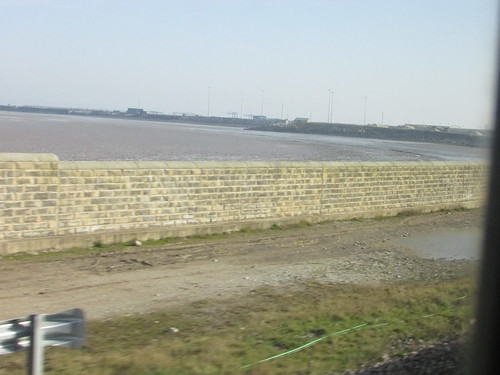
Llandudno by Rail: The Seawall at Mostyn with Mostyn Docks in the background.
Talacre signal box is now out of use but still stands where it once controlled the sidings to Point of Ayr Colliery before that closed and the Gas Terminal was built. We made our stop at Prestatyn (where I failed to check whether the now-disused signalbox was intact) before continuing to Rhyl, where the now-redundant Rhyl No. 1 signal box remains in reasonable external condition, although ivy is now climbing the front elevation.

Llandudno by Rail: Rhyl No. 1 signal box, now out-of-use.
As at Flint, there are now crossovers between the Up and Down approaching Rhyl from Chester and the LED colour light signals have been arranged to allow bi-directional working. For example, the route indicator atop signal FH6084 is for movements in an Up direction over what is normally the Down line.

Llandudno by Rail: Signal FH6084 (single-head LED colour light with route indicator on substantial post), Up Main leaving Rhyl.
Parts of the station were covered in scaffolding and a number of workman in orange overalls and hard hats were around.

Llandudno by Rail: Rhyl station Up platform. Note scaffolding above footbridge and netting above buildings.
Leaving Rhyl, we passed Rhyl No. 2 signal box which was abolished some time ago. It survives in reasonable condition with the windows painted-out. I had understood that both Rhyl No. 1 and Rhyl No. 2 (together with Mostyn signal box) were listed buildings but, on checking the Historic England database on my return I was unable to confirm whether that's correct.

Llandudno by Rail: Rhyl No. 2 signal box, taken out of use some time ago.
At Abergele, there's yet another retired signal box but the down through line which, on previous trips was controlled by this signal box, has been taken out. This is the present limit of control from the Railway Operating Centre at Manchester.
Llandudno Junction signal box now took control of our train through Colwyn Bay and 'The Junction', before handing over to Deganwy signal box.

Llandudno by Rail: Llandudno Junction signal box. Note external stairs at both ends of box and Relocatable Equipment Building.
The L&NWR manual signal box at Deganwy, like Beeston Castle, retains some tubular upper quadrant semaphore signals. Deganwy's signals, following modern practice, have rectangular identification plates carrying the signal box code ('DY') followed by the lever number. Even the Up independent distant signal carries an identification plate. Some time ago, the level crossing gates on Marine Crescent outside the signal box which had been worked mechanically from the were converted to lifting barriers. With the development of Deganwy Quay as a Marina and residential area, a lifting barrier level crossing has also been provided at the Llandudno Junction end of Deganwy station.
We were soon entering the much-simplified layout of Llandudno station, still controlled from its L&NWR-pattern manual signal box but with so much external alteration that its parentage is obscured.

Llandudno by Rail: Llandudno Station Signal Box.
Around Llandudno
Although it had been sunny on the earlier part of the journey, it was dull in Llandudno but with a very gentle breeze and local temperature (according to the internet) of 16 degrees Celsius. I immediately headed for the shore, passing the appropriately named North Western Gardens where I crossed Mostyn Street and followed Vaughan Street to the Promenade.
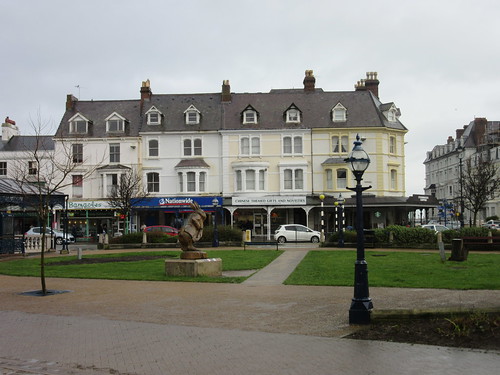
Llandudno: View across North Western Gardens showing the canopied shops in Mostyn Street.
It was very pleasant on the Promenade and I was surprised at how many people were about, some quite lightly-dressed. The advantage of the sea mist was that the off-shore wind farms were virtually invisible. The temptations of the Terrace Restaurant at the Imperial Hotel proved too strong but, by the time I'd consumed a generous portion of cream of celeriac soup with fresh rolls and butter, I only needed a pot of English Breakfast Tea to set me up for a walk along the front.

Llandudno: The Imperial Hotel pictured in 2014.
At the St. George's Hotel, I turned left into St. George's Place and continued across Mostyn Street into Lloyd Street. Here, I spent a pleasant half-hour browsing in an Antique Fair being held in the Town Hall before continuing north along Mostyn Street looking at shops. I made my way back to the shore near the Cenotaph. Llandudno is built on a peninsula which ends in the massive bulk of the Great Orme. The main promenade faces north into the Irish Sea but, just 1 kilometre away, the less-developed West Shore on the other side of the peninsula offers alternative views which I didn't have time to sample on this occasion. The main beach is mainly shingle but, near the Cenotaph there's a small sandy area of shore exposed (except at high tide) which I briefly explored before continuing along the promenade back towards the Imperial Hotel, where I left the promenade and made my way back to the station.

Llandudno: The Cenotaph and North Parade, looking towards the Great Orme

Llandudno: View of Promenade looking away from the Great Orme.
Getting back
I had left a few minutes spare to study the station re-development which, in general, I approve of. I admired the careful treatment of the preserved gates and ticket barriers originally provided by the L.M.S. Note the interlaced 'L M & S'. Contrast this with the rebuilt end wall of the overall roof with its ugly welded truss and the insensitive way the truss is jointed to the brick wall. It may be functional but did it have to be so brutal?

Llandudno Station: The LMS Ticket Barriers at the entrance to platform 2 and welded truss supporting the rebuilt end wall of the overall roof.

Llandudno Station: View from the Carriage Road showing overall roof with modern glazed end wall supported by welded trusses.
A 3-car Class 175 Diesel Multiple Unit quietly arrived in platform 3 and, almost immediately, the signalman cleared the platform starting signal for the train to depart. Arriving passengers got off, departing passengers boarded and the driver and guard 'changed ends' so that we departed within about 5 minutes of the train's arrival. As we passed the signal gantry, I took another picture.
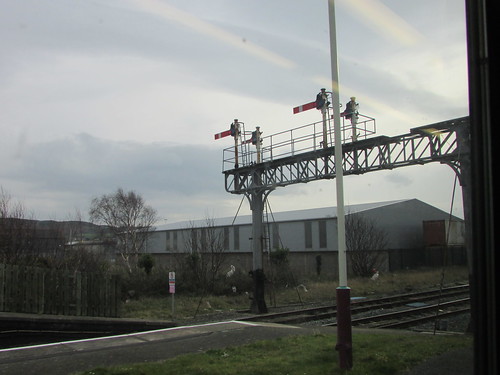
Llandudno by Rail: Platform starting signals for platforms 1 & 2 at Llandudno (Pratt Truss with four tubular upper quadrant semaphores).
The return journey was a mirror-image of the outward trip. The first train took me as far as Chester, platform 3b. My onward Crewe service (a 2-car Class 150) was waiting in platform 3a and left almost immediately. I'm not sure what the connection at Crewe was supposed to be but we arrived in platform 9 and, by the time I'd walked to the adjacent platform 6, a 4-car Electric Multiple Unit on the Liverpool-Birmingham service was snaking over the crossovers from the Up Fast into Platform 6. Within a few minutes, I was on my way back to Wolverhampton.
I took a few, rather indifferent, photographs during the return but I'm afraid I was tiring and I find photography from modern trains with double-glazed tinted windows and harsh reflections from internal carriage lighting rarely satisfactory (except, perhaps, to clarify a technical issue thrown up by another picture).
Related posts on this website
There are a number of posts about the North Wales Line and Llandudno:-
A Trip to the Seaside (Part 1)
Journey 26-Nov-2011
A Trip to the Seaside (Part 2)
Journey 26-Nov-2011
Trip to Holyhead (Part 1: Crewe to Llandudno)
Journey 25-Jan-2014
The Holyhead to Crewe Railway Line
(posted Feb 2014)
Llandudno
Journey 30-Aug-2014 (by road)
Llandudno Railway Station
(posted Dec 2014)
Return to Llandudno
Journey 6-Feb-2016
There's also an index of posts describing some of my railway journeys exploring Britain. I'm afraid they're not very adventurous trips, with many destinations repeated but you can find the list here.
Book References
For convenience, the bibliography which appeared in earlier posts about the North Wales Line is repeated here:-
[1] 'Railways to the Coast' by Michael H. C. Baker, published by Patrick Stephens (ISBN 1-85260-058-6).
[2] 'Recollections of a Steam Era (1950-1966)' by H. Rogers Jones, published by David Rogers Jones (ISBN: 0-9539720-0-03).
[3] 'LMS Branch Lines in North Wales Volume 1' by W. G. Rear, published by Wild Swan Publications (ISBN 0 906867 37 1).
[4] 'An Historical Survey of Selected LMS Stations' by Dr. R. Preston Hendry & R. Powell Hendry, published by Oxford Publishing Co. (ISBN 0-86093-330-X).
[5] 'A Pictorial Record of L.M.S. Architecture' by V. R. Anderson and G. K. Fox, published by Oxford Publishing Co. (SBN 86093 083 1).
[6] 'A Historical Survey of Chester to Holyhead Railway Track Layouts and Illustrations' by V. R. Anderson and G. K. Fox, published by Oxford Publishing Co. (ISBN 0 86093 216 8).
[7] 'A Regional History of the Railways of Great Britain: Volume 11 North and Mid Wales by Peter E Baughan, published by David & Charles (ISBN 0-9153-7850-3).
My pictures
Where necessary, clicking on an image above will display an 'uncropped' view or, alternately, pictures may be selected, viewed or downloaded, in various sizes, from the albums below:-
In making my (often quite poor) pictures available on the internet, I have divided them into various albums each covering a roughly-defined geographical area. Within each album, photographs are normally arranged by date taken. Thus, by searching through the appropriate album, you can find changes through time. So, my trip to Llandudno added pictures to a number of albums as we moved through various areas.
The journey:
West Midland Railways (Wolverhampton).
Stafford Area rail.
Crewe Area rail.
North Wales Line (Crewe - Llandudno)
The destination:
Llandudno
In February 2018, I wrote a piece called Watching The Ships Go By about the ability to remotely track and even watch the movement of ships through the wonders of modern technology and the internet. I though it was time I mentioned remotely watching trains.
Railcam UK Limited is a company limited by guarantee operated on a not-for-profit basis entirely by volunteers which runs the site Railcam UK, with its sub-title "Bringing the lineside to your armchair" and offers live webcams and an astonishing range of railway data to supporters. You can log-in as a 'guest' for free to enjoy some of the facilities and get to understand the extensive site features but a modest annual subscription will give you 'supporter' status and unrestricted access.
Remote Train Watching
The 'Dashboard' of the cameras function lists over 80 webcams, viewing main lines throughout Great Britain (from cameras on adjacent private property), heritage lines and even international sites. Many of these cameras are linked to live data from Network Rail so that the pictures are supplemented by information alerting the viewer to approaching trains and their identity.
With modern smartphones, it's possible to view this information 'on the go' as well as from the comfort of an armchair.

Railcam.UK live camera at Crewe North Jn. showing train 1D54, operated by a Class 150, leaving for Chester, as viewed on my mobile from the front coach!
Remote Live Diagrams and Data
An amazing facility shows detailed track diagrams of most of the railways in Great Britain and most of these are linked to live feeds from Network Rail which display the location of trains with their headcodes together with main signal aspects in (almost) real time. Clicking on a displayed headcode brings up comprehensive timetable and other information on that working.
You don't have to use your armchair. The photograph below shows how you can track the progress of a train you're actually travelling on. As each signal is passed, the train headcode steps to occupy the next 'berth' on the diagram. When a berth is empty, the associated signal number is displayed instead. In the picture below, signal SC5643 has replaced to danger behind my train so the empty berth now shows a greyed-out '5643'.

Llandudno by Rail: The Railcam.UK live diagram shows 1F36 passing Madeley Jn. on the Down Slow as my train (1F36) actually passes Madeley Jn. The diagram also confirms that the signal behind us (5643) has been replaced to 'red' to protect the train.
Click here for larger versions of this image.
Other features of Railcam.UK
Open Rail railway data (supplied from Network Rail) lets you interrogate full timetable data in various ways and even check historical running data for the previous 2 weeks. There's also a Chat Room.
For some years now, I have made annual visits to Myanmar (formerly Burma) in connection with the educational and medical charitable initiatives managed by Doctor Hla Tun. My last visit to the 'Future Generation' Drop In Centre in Mawlamyine on 24th April 2018 is described in the post here.
I was delighted learn from the Doctor of the success of three of the young people from 'Future Generation' in receiving 'Outstanding Student' awards.

Outstanding Students, Future Generation D.I.C.
In my own country, rather curious ideas seem to have taken over education which can be summarised as "All must have prizes". Testing has been downgraded and failure is not recognised. Whilst I agree that young people should not be humiliated for finding difficulty with learning, removing the urge to strive helps no-one. When young people grow up, the world outside will certainly punish failure so preparing them at an earlier age in a sympathetic environment is a kindness. Education in Burma remains similar to what I was used to all those years ago when I was at school. I didn't enjoy it much at the time, but I was better prepared for adult life.
Congratulations!
More pictures
Outstanding Students, Future Generation D.I.C.
I made a brief visit to Blackpool on Saturday, 9th February 2019.
Seaside resorts out-of-season have appealed to me for a long time and I wanted to travel between Preston and Blackpool to see the now-completed railway electrification. Although strong winds were forecast, it looked as if the Saturday had the best chance of being dry with some sunshine so I pre-booked tickets on the internet the day before to be collected from Wolverhampton station as I departed on the Saturday. I'd booked to 'Blackpool (Any)' and the 'best connection' from Preston on the outward journey was shown as to Blackpool South. An ordinary ticket now costs around eighty (80) times what I paid for a trip in 1957 which is recollected here.
This was my first trip to Blackpool for almost three years (that trip is described starting here). Using our local bus service to get from my home to Wolverhampton, the earliest train I could catch was the 09:37 Virgin 'Pendolino', changing at Preston. The Virgin train was supposed to continue to Glasgow but strong winds earlier in the week had brought down the Overhead Line equipment somewhere on the route in Scotland and so my train was terminating at Preston where passengers travelling further north were advised to seek further information. The journey to Preston was on time but, for some reason, the ride quality in the leading vehicle was impaired, causing me to feel quite queasy. Finally, at Wigan, I moved to the second vehicle and remained standing for the remainder of the journey to Preston.
At Preston, I made my way across to island platform 1/2 used by the Fylde Line local trains operated by 'Northern'. This franchise replaced the previous 'Northern Rail' in April 2016. A Class 142 'Pacer' was shut down in platform 2 with the doors open and people boarding but no destination showing on the route blind. The electronic Passenger Information Display on the platform indicated that this train would shortly depart for Blackpool South (for some reason, a few minutes minutes earlier than the time the internet booking system had shown) so I climbed on board. After a short wait a driver arrived, started the engines and set the route blind. A 'Sprinter' arrived from the north in platform 1 which I correctly guessed was the service from Blackpool North.
Almost immediately, my own train set off, negotiated the curving route leaving the station and passed Preston Power Signal Box. I always feel slightly 'proprietorial' about Preston Power Signal Box because I visited it a number of times during the 1970s when my firm was designing and building telecommunications equipment for the West Coast Main Line Electrification Project (our involvement is briefly described here).

Preston to Blackpool South: North end of Preston station with the Power Signal Box half-hidden by a stabled Class 319 (refurbished after 'cascade' from the London area).
In the shadow of the imposing St. Walburge's Church, my train swung left onto the route for the coast, leaving the West Coast Main Line which continues north on the other side of the church. In the steam era, the route from Preston to Kirkham and Wesham was four-track, paired by use, but simple double track has sufficed more recently. For some distance near Preston, the disused formation which once carried the 'Fast' lines has been taken over by a road. We passed a new LED colour light signal with the identification 'BL' and four digits, indicating that we had left the Preston Power Box area and were now under the control of the Manchester Rail Operating Centre (ROC). This facility, located in Ashburys, was opened in July 2014. We were running 'under the wires'but, of course, burning diesel fuel. I've despised the four-wheeled 'Pacers' since they were introduced as a 'cheap' alternative to 'proper' trains but I was happy to note that, running on Continuous Welded Rail (CWR), the ride was considerably better than I'm used to. We bowled along past a succession of mainly automatic LED colour light signals past Salwick to our first stop at Kirkham and Wesham.
In the steam era, the Slow Lines served a single island platform whilst the Fast lines on the north side of the Slow Lines were used by 'through' trains. The Lancashire and Yorkshire Railway was quite keen on island platforms at smaller station. There was only one set of buildings to be built and maintained and the potentially dangerous practice of station staff repeatedly crossing the lines to reach the opposite platform was avoided. The station as I remember it has undergone significant change. Until a few years ago, although the line from Preston had reverted to double track, Kirkham itself retained a pair of 'through' lines which looped around the north of the station before combining with the platform lines at Kirkham North Junction. All that has now gone. A completely new track layout avoids the use of 'diamond crossings' altogether, using only simple turnouts. A a new platform (No.3) has been added on the north side for all Up trains. It appears that Down trains to Blackpool South use the original platform 1, whilst Down trains to Blackpool North now use platform 2, formerly the 'Up' platform. The handsome brick building on platforms 1/2 has been retained but the main station building, which was located on the road overbridge providing access, has gone, replaced by a footbridge accessing the road with steps down to the original island platform and the totally new Up platform. Two new brick lift towers provide disabled access to the platforms.

Blackpool's Railways: The new platform 3 at Kirkham and Wesham.
Leaving Kirkham, two lines curved to the left after Kirkham North Junction. Colour light BL5813 was showing 'green' for us: BL9815 on the adjacent line correctly maintained a 'red'. The two lines converged and we made good speed over the CWR single line. Just before Moss Side station, I saw the 'flashing white' light beckoning us across the level crossing there. The extensive station building at Lytham survives, although the platform face doesn't look quite right to me. But, according to recent photographs, the rather more grand facade facing the road still looks impressive with the building now serving as the Station Pub and Grill.

Preston to Blackpool South: Lytham Station (platform side).
We made brief stops at Ansdell and Fairhaven, St. Annes-on-Sea and Squire's Gate. I was surprised to see a sign for 'Blackpool International Airport' at Squire's Gate station. My very first flight in an aircraft was from Wolverhampton to Squire's Gate (as it was then known). My recollection of that flight in the 1960s is here but, in the 1990s, I visited the airfield again during a holiday with my late partner, Daemon. It's an interesting and historic airfield, described on the operator's website here. The Wikipedia article here explains that the airfield dropped its 'International' status in 2014.
Blackpool Pleasure Beach had a single platform on the seaward side with a small section of umbrella roofing (but little else). As we continued to our final stop we had good views of the larger rides at Pleasure Beach on our left, before gently coming to a halt in the single platform of Blackpool South where the line now terminates.
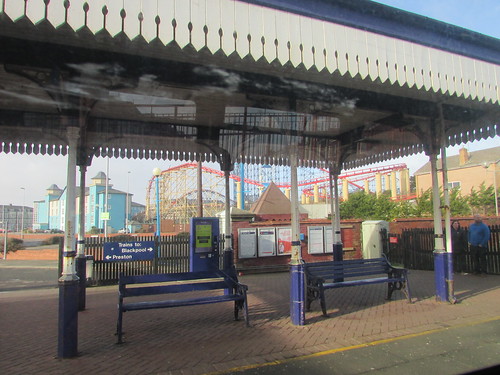
Preston to Blackpool South: Blackpool Pleasure Beach Station.
The route I'd just used was completed in 1874 and continued a further mile to the well-named Blackpool Central Station. The coastal route from Kirkham Blackpool Central limited capacity so, in 1903, with burgeoning holiday traffic, a direct line was built from Kirkham to a junction at Blackpool South with four running lines and extensive sidings extending on to Blackpool Central. There's a little more in my post Railways around Blackpool. In 1964, Blackpool South was closed and the former railway redeveloped in part, mainly as car parks and roads.
Beyond the present buffer stop, the original Waterloo Road bridge is now part embankment, part still bridge (with Seasiders Way where tracks used to be).

Preston to Blackpool South: Blackpool South Station, looking towards the buffer stop.

Preston to Blackpool South: Blackpool South Station showing car park on the route of the line which formerly continued to Blackpool Central and railway bridges 're-purposed' for Seasiders Way.
The remaining platform includes the platform face of the original Down line from Lytham which, with the now-removed Up Lytham, formed an island platform. When the 1903 direct line was built, this was served by additional platforms, now removed.
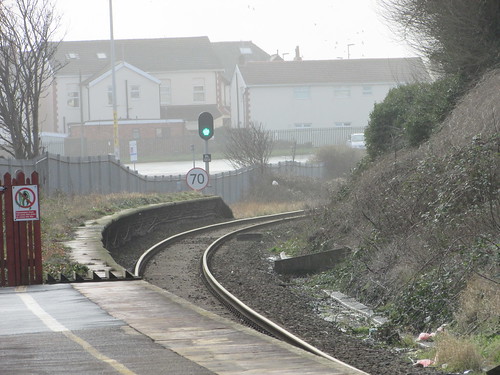
Preston to Blackpool South: Blackpool South Station, with signal BL3825 clear for my train to return to Preston.
The excellent 'Disused Stations' site has a brief history of Blackpool Central here.
I left the station and took Waterloo Road to the junction with Lytham Road and decided to follow this road, parallel to the promenade towards the centre of Blackpool. Lytham Road is mainly commercial, with a mixture of cafes, pubs, small businesses, shops and empty premises looking, for the most part, as if it had fallen on hard times. On both sides of the road, a grid of side streets had been developed with decent brick dwellings, some offering bed and breakfast facilities. I was rather taken by one enterprise offering to buy cars "Dead or Alive". I continued along Lytham Road as it bent to the left, towards the promenade but when I saw overhead wires for trams ahead, I realised I must be near the Rigby Road Tram Depot so I followed the wires and tram tracks along Hopton Road to the gated entrance of the original Tram Depot and Works.

Blackpool Trams: Entrance to Rigby Road depot and works, viewed from Hopton Road.
The tram depot is now home only to the remaining earlier trams which, during the season, operate a 'Heritage' service. The modern Bombardier 'Flexity2' trams are serviced in a new depot at the southern end of the tram system at Starr Gate, just a few hundred yards from Squire's Gate railway station I'd passed through earlier. There's a detailed article about Blackpool Tramway on Wikipedia here.
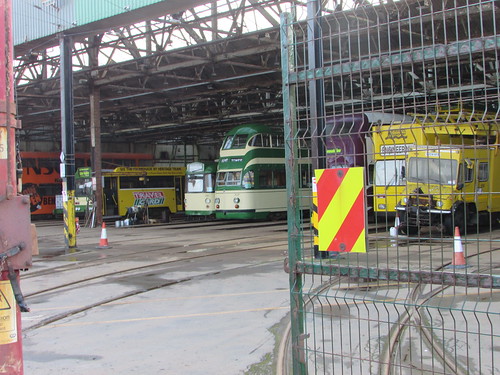
Blackpool Trams: Rigby Road depot showing 'Heritage' trams.
As I retraced my route back to Lytham Road, I paused to look at the inset track pointwork, made by Edgar Allen and Company Limited. There's a brief history of this firm on the useful Grace's Guide website here.

Blackpool Trams: Detail of inset track pointwork at Rigby Road depot and works.
I continued my walk north but found the tantalising views through side streets of the grey, troubled sea irresistible so I finally made my way to the exposed, windy promenade.

Blackpool Promenade on a bright, windy day in February. View looking south, with the Pleasure Beach and South Pier in the distance.
The Central Pier was open, with quite a few people exploring the smaller amusements which were open for business. Before leaving the pier, I took a picture looking north towards the third of Blackpool's Piers with the famous tower on the right.

Blackpool: View of North Pier and the Tower on a pleasant but windswept day in February.
As I passed the iconic Blackpool Tower, I came across the extraordinary Comedy Carpet, inspired by the work of hundreds of entertainers. Commissioned by Blackpool Council and funded by £2,600,000 from CABE (the Commission for Architecture and the Built Environment) the carpet has its own website here.
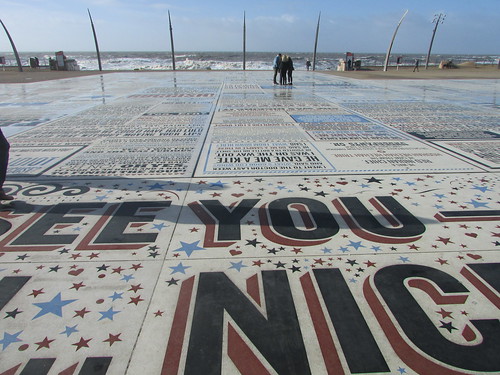
Blackpool: The 'Comedy Carpet' opposite the Tower.
As I approached the North Pier, I took a picture of the rough sea (for comparison with a similar picture in my 2014 post A Trip to the Seaside).
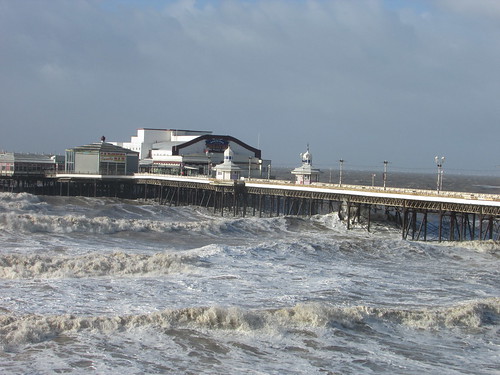
Blackpool North Pier in a rough sea.
I'd decided to continue to Blackpool North Station, via Talbot Road opposite the North Pier. An extensive fenced-off area protecting road works meant something of a detour to reach Talbot Road, allowing me to see that a double-track triangular junction was being installed in the tram route to Fleetwood, with new double track tramway being built through further roadworks along Talbot Road. I guessed that the extension would serve Blackpool North Station and this was confirmed by a large poster I passed as I neared the railway station.

Blackpool Tramway Extension Display in Talbot Road.
Click here for larger view
After passing through the automatic ticket barriers on entering the station, passengers are admitted to the concourse area and allowed to form queues near the appropriate departure platform doors until shortly before departure. So I had no time to walk to the far and of the platform to study the station throat and had to confine myself to a few indifferent shots as we left. Notably, my train to Preston was a 4-car Diesel Multiple Unit, although we were clearly running 'under the wires'. Each platform had an LED colour light main signal surmounted by a theatre-type route indicator, together with a position-light subsidiary signal. Two smaller indicators were also provided - I presumed one was a 'Right Away' indicator for the main aspect showing 'RA' and the other a route indicator for the subsidiary aspect but I couldn't confirm that.

Blackpool's Railways: A group of LED Colour Light signals at Blackpool North.
Soon we passed a Relocatable Equipment Building (REB) in a fenced compound which I assumed was the signalling equipment room for the area. I could see no trace of the wonderful Lancashire and Yorkshire Railway mechanical signal box which previously controlled the station.

Blackpool's Railways: Blackpool North Equipment Room on Up side.
In the extensive sidings on the Up side, I spotted at least three Class 319 Electric Multiple Units. This class was built between 1987 and 1990 by BREL in York and were mainly used on Thameslink services through London until replaced by Class 700. Following refurbishment, these 'hand-me-downs' entered service with Northern Rail and are currently operated by Northern. Near the main line, there was also a brand-new Class 195 'Civity' diesel Multiple unit. Originally intended for introduction by the end of 2018, 'integration issues' have delayed this to 'Spring 2019'. Northern intend to introduce a re-vamped timetable it May 2019 so it is to be hoped that the issues can be promptly resolved.

Blackpool's Railways: Class 319 and Class 195 in the sidings at Blackpool North.
We made brief stops at Layton, Poulton-le-Fylde (where the Burn Naze branch has now been completely severed) and finally Kirkham and Wesham before continuing to Preston's platform 2.
By this time, I was getting quite tired, so I anxiously looked for a suitable train south. Because of the problems in Scotland, northbound Virgin trains were still terminating at Preston and then returning south. It appeared that one of these services was due to depart in about ten minutes and would take me directly to Wolverhampton. I took a few pictures at the north end of platform 5/6 before joining the Quiet Coach of my Virgin 'Pendolino' train.

Preston: View of Fishergate Bridge looking north from Platform 5/6 with Up and Down Goods on extreme right.

Preston: Looking south on platform 5/6 showing Pendolino departing at 14:20 for Euston via Birmingham.
I had the Quiet Coach entirely to myself throughout the journey (so it really was quiet!). Adjacent coaches we also lightly-loaded and the Guard confirmed that this was because the train had originated at Preston, not Glasgow. At Warrington, we passed a waiting train of biomass to fuel Drax Power Station with Railfreight Class 60 number 60002 'Tempest' on the front. Of all the ideas to reduce climate change, hauling biomass halfway round the world to generate electricity strikes me as particularly bizarre.
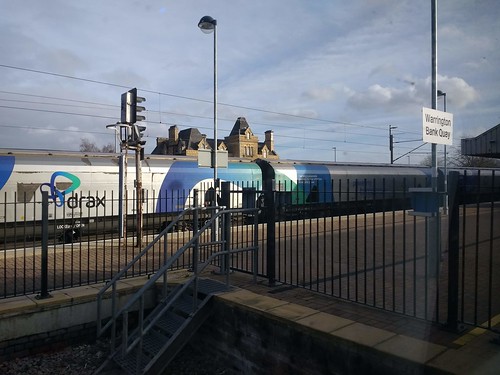
Warrington area rail: A waiting train of biomass heading for Drax Power Station.
As we continued south from Warrington, the afternoon sun was highlighting the concrete tower at Daresbury Laboratory which has always struck me as rather 'spooky' so, when I got home, I looked up the Wikipedia entry here and the laboratory's own website here.
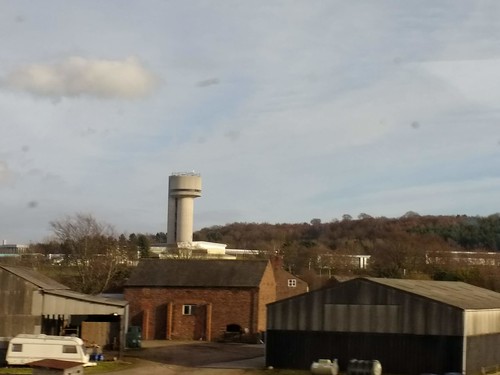
Warrington area rail: Daresbury Laboratory viewed from an Up train.
I was back in Wolverhampton early enough to get my last bus home (4.05 p.m. from Wolverhampton - country buses are not brilliant. It has been a short trip, as usual very tiring but extremely interesting.
Related posts on other websites
Blackpool North railway station (Wikipedia).
Disused Stations: Blackpool Central.
Blackpool Airport.
Blackpool Airport (Wikipedia).
Blackpool Tramway (Wikipedia).
Daresbury Laboratory (Wikipedia).
Daresbury Laboratory (Science & Technology Facilities Council).
Related posts on this website
Halfex to Blackpool.
A Trip to the Seaside.
Railways around Blackpool.
Return to Blackpool and Fleetwood (part 1).
Return to Blackpool and Fleetwood (part 2).
My pictures
Where necessary, clicking on an image above will display an 'uncropped' view or, alternately, pictures may be selected, viewed or downloaded, in various sizes, from the albums below:-
In making my (often quite poor) pictures available on the internet, I have divided them into various albums each covering a roughly-defined geographical area. Within each album, photographs are normally arranged by date taken. Thus, by searching through the appropriate album, you can find changes through time. So, my straightforward trip to Blackpool added pictures to a number of albums as we moved through various areas.
The journey:
West Midland Railways (Wolverhampton).
Stafford Area rail.
Crewe Area rail.
Liverpool area rail (Winsford-Weaver Jn).
Warrington Area rail.
Wigan's Railways.
Railways around Preston.
Blackpool's Railways.
The destination:
Blackpool Trams.
Blackpool and Fleetwood.
The Bagan Medical Clinic was officially opened on 30th October 2011, as described here, although treatments started on 6th August 2011.
My previous update showed monthly statistics up to the end of September, 2017, when the total number of treatments carried out was 207,345.
The Clinic is normally open on Friday, Saturday and Sunday but from the middle of July 2018, patient numbers rose and the Clinic additionally opened on Mondays, allowing around 1,100 treatments each week provided Dr. Hla Tun worked until 2.00 a.m. each day and the other two Doctors worked until midnight. With the temporary help of another Doctor, in one week 1,300 patients were seen.

Bagan Clinic end August: A free lunch is provided for waiting patients
and their companions (Photo: Dr. Hla Tun)

Bagan Clinic end September. The Abbott talks to waiting patients
(Photo: Dr. Hla Tun)
Treatment Summary
The table below shows the number of treatments per month from October 2017 to end of December 2018. The total number of treatments since the Bagan Medical Clinic opened in 2011 has now passed a quarter of a million, a remarkable achievement.
| Month |
Treatments in month |
Total treatments |
| October 2017 |
1,903 |
209,248 |
| November 2017 |
1,973 |
211,221 |
| December 2017 |
2,266 |
213,487 |
| January 2018 |
1,751 |
215,238 |
| February 2018 |
1,609 |
216,847 |
| March 2018 |
2,157 |
219,004 |
| April 2018 |
1,261 |
220,265 |
| May 2018 |
2,258 |
222,523 |
| June 2018 |
2,813 |
225,336 |
| July 2018 |
2,972 |
228,308 |
| August 2018 |
5,149 |
233,457 |
| September 2018 |
7,428 |
240,885 |
| October 2018 |
3,210 |
244,095 |
| November 2018 |
3,044 |
247,139 |
| December 2018 |
2,877 |
250,016 |
Notes
The Bagan Medical Clinic is open throughout the year except for one or two weeks during April because of the Water Festival ('Thingyan') and Myanmar New Year.
Doctor Hla Tun is also Chief Medical Officer aboard the 'Road to Mandalay' river cruise ship operated by Belmond. During much of the season, this ship shuttles between Shwe Kyet Yet (near Mandalay) and Bagan, mooring at Bagan (close to the Bagan Clinic) from Friday to Monday, whilst the ship's guests explore the wonders of the pagodas spread across the Bagan Plain. This allows Doctor Hla Tun to normally open the Bagan Clinic on Friday, Saturday and part of Sunday. Doctor Hla Tun typically sees 90 patients each day the Clinic is open. Less complex cases are seen by two other doctors.
Free Lunches
A free lunch is served to patients and their companions on the clinic days.
Other reports on medical support in Myanmar
There are a number of posts in this Blog describing medical support in Myanmar provided by the RTM Social Contribution with help from donors around the world. You can find them all here.
Photographs
There's a collection of pictures showing the Bagan Clinic from its inception here.
Doctor Hla Tun's photographs illustrating the work of the Bagan Clinic can be accessed by the following links:-
2014
2015
2016
2018

















































